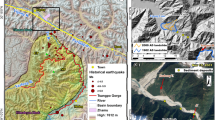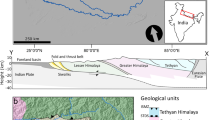Abstract
Mass wasting caused by large-magnitude earthquakes chokes mountain rivers with several cubic kilometres of sediment. The timescale and mechanisms by which rivers evacuate small to gigantic landslide deposits are poorly known, but are critical for predicting post-seismic geomorphic hazards, interpreting the signature of earthquakes in sedimentary archives and deciphering the coupling between erosion and tectonics. Here, we use a new 2D hydro-sedimentary evolution model to demonstrate that river self-organization into a narrower alluvial channel overlying the bedrock valley dramatically increases sediment transport capacity and reduces export time of gigantic landslides by orders of magnitude compared with existing theory. Predicted export times obey a universal non-linear relationship of landslide volume and pre-landslide valley transport capacity. Upscaling these results to realistic populations of landslides shows that removing half of the total coarse sediment volume introduced by large earthquakes in the fluvial network would typically take 5 to 25 years in various tectonically active mountain belts, with little impact of earthquake magnitude and climate. Dynamic alluvial channel narrowing is therefore a key, previously unrecognized mechanism by which mountain rivers rapidly digest extreme events and maintain their capacity to incise uplifted rocks.
This is a preview of subscription content, access via your institution
Access options
Access Nature and 54 other Nature Portfolio journals
Get Nature+, our best-value online-access subscription
$29.99 / 30 days
cancel any time
Subscribe to this journal
Receive 12 print issues and online access
$259.00 per year
only $21.58 per issue
Buy this article
- Purchase on Springer Link
- Instant access to full article PDF
Prices may be subject to local taxes which are calculated during checkout





Similar content being viewed by others
References
Yanites, B. J., Tucker, G. E., Mueller, K. J. & Chen, Y. How rivers react to large earthquakes: evidence from central Taiwan. Geology 38, 639–642 (2010).
Li, G. et al. Connectivity of earthquake-triggered landslides with the fluvial network: implications for landslide sediment transport after the 2008 Wenchuan earthquake. J. Geophys. Res. 121, 703–724 (2016).
Wang, J. et al. Controls on fluvial evacuation of sediment from earthquake-triggered landslides. Geology 43, 115–118 (2015).
Steer, P., Simoes, M., Cattin, R. & Shyu, J. B. H. Erosion influences the seismicity of active thrust faults. Nat. Commun. 5, 5564 (2014).
Howarth, J. D., Fitzsimons, S. J., Norris, R. J. & Jacobsen, G. E. Lake sediments record cycles of sediment flux driven by large earthquakes on the Alpine fault, New Zealand. Geology 40, 1091–1094 (2012).
Korup, O., Densmore, A. L. & Schlunegger, F. The role of landslides in mountain range evolution. Geomorphology 120, 77–90 (2010).
Li, G. et al. Seismic mountain building: landslides associated with the 2008 Wenchuan earthquake in the context of a generalized model for earthquake volume balance. Geochem. Geophys. Geosyst. 15, 833–844 (2014).
Dadson, S. et al. Links between erosion, runoff variability and seismicity in the Taiwan orogen. Nature 426, 648–651 (2003).
Larsen, I. & Montgomery, D. Landslide erosion coupled to tectonics and river incision. Nat. Geosci. 5, 468–473 (2012).
Ouimet, W. The hills came tumbling down. Nat. Geosci. 4, 424–425 (2011).
Densmore, A., Anderson, R., McAdoo, B. & Ellis, M. Hillslope evolution by bedrock landslides. Science 275, 369–372 (1997).
Parker, R. N. et al. Mass wasting triggered by the 2008 Wenchuan earthquake is greater than orogenic growth. Nat. Geosci. 4, 449–452 (2011).
Marc, O., Hovius, N. & Meunier, P. The mass balance of earthquakes and earthquake sequences. Geophys. Res. Lett. 43, 1–9 (2016).
Hovius, N., Meunier, P., Lin, C. & Chen, H. Prolonged seismically induced erosion and the mass balance of a large earthquake. Earth Planet. Sci. Lett. 304, 347–355 (2011).
Robinson, T. R. & Davies, T. R. H. Potential geomorphic consequences of a future great (Mw = 8.0 +) Alpine Fault earthquake, South Island, New Zealand. Nat. Hazards Earth Syst. Sci. 13, 2279–2299 (2013).
Huang, R. Q. & Li, W. L. Analysis of the geo-hazards triggered by the 12 May 2008 Wenchuan Earthquake, China. Bull. Eng. Geol. Environ. 68, 363–371 (2009).
Keefer, D. Earthquake-induced landslides and their effects on alluvial fans. J. Sediment. Res. 69, 84–104 (1999).
Zhang, S., Zhang, L., Lacasse, S. & Nadim, F. Evolution of mass movements near epicentre of Wenchuan Earthquake, the first eight years. Sci. Rep. 6, 36154 (2016).
Croissant, T., Lague, D., Davy, P., Davies, T. & Steer, P. A precipiton-based approach to model hydro-sedimentary hazards induced by large sediment supplies in alluvial fans. Earth Surf. Process. Landf. http://dx.doi.org/10.1002/esp.4171 (2017).
Dadson, S. J. et al. Earthquake-triggered increase in sediment delivery from an active mountain belt. Geology 32, 733–736 (2004).
Berryman, K. R. et al. Major earthquakes occur regularly on an isolated plate boundary fault. Science 336, 1690–1693 (2012).
Egholm, D. L., Knudsen, M. F. & Sandiford, M. Lifespan of mountain ranges scaled by feedbacks between landsliding and erosion by rivers. Nature 498, 475–478 (2013).
Davy, P., Croissant, T. & Lague, D. A precipiton method to calculate river hydrodynamics, with applications to flood prediction, landscape evolution models and braiding instabilities. J. Geophys. Res. http://dx.doi.org/10.1002/2016JF004156 (2017).
Cui, Y., Parker, G., Pizzuto, J. & Lisle, T. E. Sediment pulses in mountain rivers: 2. Comparison between experiments and numerical predictions. Wat. Resour. Res. 39 (2003).
Benda, L. & Dunne, T. Stochastic forcing of sediment supply to channel networks from landsliding and debris flow. Wat. Resour. Res. 33, 2849–2863 (1997).
Sutherland, D. G., Ball, M. H., Hilton, S. J. & Lisle, T. E. Evolution of a landslide-induced sediment wave in the Navarro River, California. Bull. Geol. Soc. Am. http://dx.doi.org/10.1130/0016-7606 (2002).
Cui, Y. & Parker, G. Numerical model of sediment pulses and sediment-supply disturbances in mountain rivers. J. Hydraul. Eng. 131, 646–656 (2005).
Cantelli, A., Paola, C. & Parker, G. Experiments on upstream-migrating erosional narrowing and widening of an incisional channel caused by dam removal. Wat. Resour. Res. 40, 1–12 (2004).
Marc, O., Hovius, N., Meunier, P., Gorum, T. & Uchida, T. A seismologically consistent expression for the total area and volume of earthquake-triggered landsliding. J. Geophys. Res. 121, 640–663 (2016).
Robinson, T. R., Davies, T. R. H., Wilson, T. M. & Orchiston, C. Coseismic landsliding estimates for an Alpine Fault earthquake and the consequences for erosion of the Southern Alps, New Zealand. Geomorphology 263, 71–86 (2016).
Lague, D. The stream power river incision model: evidence, theory and beyond. Earth Surf. Process. Landf. 39, 38–61 (2014).
Malamud, B. D., Turcotte, D. L., Guzzetti, F. & Reichenbach, P. Landslide inventories and their statistical properties. Earth Surf. Process. Landf. 29, 687–711 (2004).
Pearce, A. J. & Watson, A. J. Effects of earthquake-induced landslides on sediment budget and transport over a 50-yr period. Geology 14, 52–55 (1986).
Korup, O., McSaveney, M. J. & Davies, T. R. Sediment generation and delivery from large historic landslides in the Southern Alps, New Zealand. Geomorphology 61, 189–207 (2004).
Korup, O. Landslide-induced river channel avulsions in mountain catchments of southwest New Zealand. Geomorphology 63, 57–80 (2004).
Castelltort, S. et al. River drainage patterns in the New Zealand Alps primarily controlled by plate tectonic strain. Nat. Geosci. 5, 744–748 (2012).
Kritikos, T. Geomorphic Hazard Analyses in Tectonically-Active Mountains: Application to the Western Southern Alps, New Zealand (Univ. Canterbury, 2013).
Bookhagen, B. & Strecker, M. R. Spatiotemporal trends in erosion rates across a pronounced rainfall gradient: examples from the southern Central Andes. Earth Planet. Sci. Lett. 327–328, 97–110 (2012).
Martha, T. R., Roy, P., Mazumdar, R., Govindharaj, K. B. & Kumar, K. V. Spatial characteristics of landslides triggered by the 2015 Mw 7.8 (Gorkha) and Mw 7.3 (Dolakha) earthquakes in Nepal. Landslides 14, 697–704 (2017).
Davy, P. & Lague, D. Fluvial erosion/transport equation of landscape evolution models revisited. J. Geophys. Res. 114, F03007 (2009).
Meyer-Peter, E. & Müller, R. Formulas for Bed-Load Transport (IAHSR, 1948).
Lajeunesse, E., Malverti, L. & Charru, F. Bed load transport in turbulent flow at the grain scale: experiments and modeling. J. Geophys. Res. 115, F04001 (2010).
Nicholas, A. P. Modelling the continuum of river channel patterns. Earth Surf. Process. Landf. 38, 1187–1196 (2013).
Sekine, B. M., Member, A. & Parker, G. Bed-load transport on transverse slope. I. J. Hydraul. Eng. 118, 513–535 (1992).
Seizilles, G., Devauchelle, O., Lajeunesse, E. & Métivier, F. Width of laminar laboratory rivers. Phys. Rev. E 87, 1–5 (2013).
Métivier, F., Lajeunesse, E. & Devauchelle, O. Laboratory rivers: Lacey’s law, threshold theory, and channel stability. Earth Surf. Dyn. 5, 187–198 (2017).
Parker, G., Wilcock, P. R., Paola, C., Dietrich, W. E. & Pitlick, J. Physical basis for quasi-universal relations describing bankfull hydraulic geometry of single-thread gravel bed rivers. J. Geophys. Res. 112, 1–21 (2007).
Montgomery, D. R. & Dietrich, W. E. Channel initiation and the problem of landscape scale. Science 255, 826–830 (1992).
Snyder, N. P., Whipple, K. X., Tucker, G. E. & Merritts, D. J. Landscape response to tectonic forcing: digital elevation model analysis of stream profiles in the Mendocino triple junction region, northern California. Geol. Soc. Am. Bull. 112, 1250–1263 (2000).
Rodriguez-Iturbe, I. & Rinaldo, A. Fractal River Basins: Chance and Self-Organization (Cambridge Univ. Press, 2001).
Larsen, I. J., Montgomery, D. R. & Korup, O. Landslide erosion controlled by hillslope material. Nat. Geosci. 3, 247–251 (2010).
Acknowledgements
T.C. and P.S. acknowledge support by the EROQUAKE project funded by the Agence Nationale de le Recherche (ANR) and D.L. acknowledges support by the CNRS/INSU/ALEAS project SEDIQUAKE. A. Bandopadhyay is warmly thanked for his helpful insights concerning the mathematical development of the Monte Carlo approach. We thank D. Jerolmack and R. Hodge for their insightful comments that helped improve the quality of the manuscript.
Author information
Authors and Affiliations
Contributions
All authors contributed equally to the design of the study and the writing of the paper. T.C. designed and performed the simulations and processed their results. P.D. developed the numerical model. T.C., P.S. and D.L. developed the stochastic approach.
Corresponding author
Ethics declarations
Competing interests
The authors declare no competing financial interests.
Supplementary information
Supplementary Information
Supplementary Information (PDF 1264 kb)
Supplementary Information
Supplementary Information (GIF 3112 kb)
Supplementary Information
Supplementary Information (GIF 833 kb)
Rights and permissions
About this article
Cite this article
Croissant, T., Lague, D., Steer, P. et al. Rapid post-seismic landslide evacuation boosted by dynamic river width. Nature Geosci 10, 680–684 (2017). https://doi.org/10.1038/ngeo3005
Received:
Accepted:
Published:
Issue Date:
DOI: https://doi.org/10.1038/ngeo3005
This article is cited by
-
Surface temperature controls the pattern of post-earthquake landslide activity
Scientific Reports (2022)
-
Research on geological and surfacial processes and major disaster effects in the Yellow River Basin
Science China Earth Sciences (2022)
-
Exportation of coseismic deposits in areas affected by the Wenchuan earthquake
Landslides (2022)
-
Quantitative investigation of the spatiotemporal evolution of coseismic deposits and its influence on the magnitude of postseismic debris flows in the Hongchun valley, Wenchuan County, China
Landslides (2021)
-
Quantitative investigation of post-seismic debris flows considering the spatial distribution of source materials
Environmental Earth Sciences (2021)



